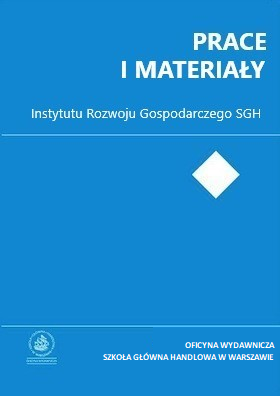On the Usefulness of Financial Variables Realised Volatility for Recession Forecasting and Business Cycles Turning Points Dating
##plugins.themes.bootstrap3.article.main##
Abstrakt
The main goal of this paper was to check usefulness of introducing measures of the financial markets risk into multivariate forecasting and business cycle dating models to improve their predictive and turning points detection power. Realised volatility was selected as market risk synthetic measure and introduced into two recession dating algorithms: Harding & Pagan (2002) mechanical procedure and Markov Switching Dynamic Factor Model (MS-DFM) with mixed frequencies and missing data handling. In the theoretical part of the article mathematical background of the realised volatility concept and MS-DFM model were presented. It was also described how the output of the MS-DFM model can be used to date turning points. This approach to local maxima detection was compared with Harding and Pagan competitor algorithm. In the practical part of the paper recession detection improvements stemming from introduction of realised volatility measures into MS-DFM model/Harding & Pagan procedure were examined for US and four Western Europe countries (Germany, France, United Kingdom and Italy) in the time span of 20 years between 1990 and 2010.(original abstract)
##plugins.themes.bootstrap3.article.details##
Bibliografia
Andersen, T. G., Bollerslev, T., Cai, J. (2000). Intraday and interday volatility in the Japanese stock market. Journal of International Financial Markets, Institutions and Money, Elsevier, 10 (2), 107-130.
Andersen, T. G., Bollerslev, T., Diebold, F. X, Labys, P. (2001).
The distribution of realized exchange rate volatility. Journal of the American Statistical Association, 96, 42-55.
Andersen, T. G., Bollerslev, T., Diebold, F.X., Labys, P. (2003). Modeling and forecasting realized volatility, Econometrica, 71 (2), 579-625.
Andersen, T. G., Bollerslev, T., Meddahi, N. (2004). Analytical evaluation of volatility forecasts. International Economic Review, 45 (4), 1079-1110.
Andersen, T.G., Bollerslev, T., Diebold, F.X., Vega, C. (2007). Real-time price discovery in global stock, bond and foreign exchange markets. Journal of International Economics, 73 (2), 251-277.
Ang, A., Bekaert, G. (2002). International asset allocation with regime shifts.
Review of Financial Studies, 15 (4), 1137-1187.
Barndorff-Nielsen, O. E. (2004). Power and bipower variation with stochastic volatility and jumps, Journal of Financial Econometrics, 2 (1), 1-37.
Barndorff-Nielsen, O. E., Graversen, S. E., Jacod, J., Shephard, G. (2005).
Limit theorems for bipower variation in financial econometrics. OFRC Working Papers Series.
Camacho, M., Pérez-Quirós, G. (2009). Introducing the Euro-STING: Short-term indicator of Euro Area growth. CEPR Discussion Papers, 7343.
Chauvet, M. (1998). An econometric characterization of business cycle dynamics with factor structure and regime switching. International Economic Review, 39 (4), 969-96.
Chauvet, M., Hamilton, J. D. (2005). Dating business cycle turning points.
NBER Working Papers, 11422, National Bureau of Economic Research.
Chauvet, M., Piger, J. (2008). A comparison of the real-time performance of business cycle dating methods. Journal of Business & Economic Statistics, 26, 42-49.
Corsi, F., Mittnik, S., Pigorsch, C., Pigorsch, U. (2008). The volatility of realized volatility. Econometric Reviews, 27 (1-3), 1-33.
Garcia, R., Perron, P. (1996). Na analysis of the real interest rate under regime shifts. The Review of Economics and Statistics, 78 (1), 111-125.
Hamilton, J. D. (1989). A new approach to the economic analysis of nonstationary time series and the business cycle. Econometrica, 57 (2), 357-84.
Hamilton, J. D. (1988). A neoclassical model of unemployment and the business cycle. Journal of Political Economy, 96 (3), 593-617.
Harding, D., Pagan, A. (2002). Dissecting the cycle: a methodological investigation. Journal of Monetary Economics, 49 (2), 365-381.
Kim, Ch. J. (1994). Dynamic linear models with Markov-switching. Journal of Econometrics, 60 (1-2), 1-22.
Kim, Ch. J., Nelson, Ch. (1999). State-space Models with Regime Switching.
Cambridge: MIT Press.
Mariano, R. S, Murasawa, Y. (2003). A new coincident index of business cycles based on monthly and quarterly series. Journal of Applied Econometrics, 18 (4), 427-443.
Stock, J. H., Watson, M. W. (1989). New indexes of coincident and leading economic indicators. NBER Macroeconomics Annual, 4, 351-409.
Stock, J. H., Watson, M. W. (1998). Business cycle fluctuations in U.S. macroeconomic time series. NBER Working Papers, 6528.
